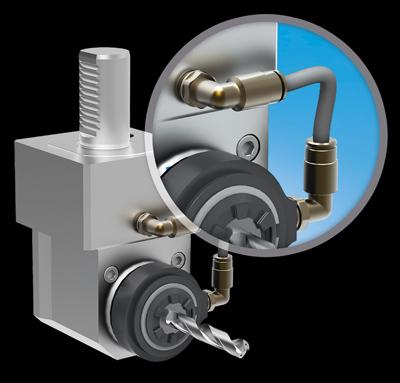
The new retrofit reCool coolant-through system from REGO-FIX is a quick, cost-effective and low-maintenance way to bring the benefits of internal cooling to the live tooling used in CNC turning operations.
reCool, which converts an existing tooling system to include through-coolant in as little as two minutes, is much more effective in getting coolant to the cutting edge than spray pipes or nozzles. It achieves standard speeds up to 6,000 rpm and pressures up to 300 psi. Higher speeds and coolant pressures are available upon request.
"By adding reCool to their CNC turning operations, manufacturers can easily remove heat from the cutting zone and achieve better surface finishes, longer tool life, improved chip control and increased productivity overall," said David McHenry, senior product engineer at REGO-FIX.
With reCool, live tools featuring external threads (ISO 15488/DIN 6499) can machine faster and last longer. The system also works in conjunction with REGO-FIX collets, sealing and coolant flush disks, milling cutters and drills with diameters from 0.098" to 1.2". Furthermore, because of its simple structure and special lubricated bearings, reCool serves as an affordable, low-maintenance internal cooling system.
Contact Details
Related Glossary Terms
- computer numerical control ( CNC)
computer numerical control ( CNC)
Microprocessor-based controller dedicated to a machine tool that permits the creation or modification of parts. Programmed numerical control activates the machine’s servos and spindle drives and controls the various machining operations. See DNC, direct numerical control; NC, numerical control.
- coolant
coolant
Fluid that reduces temperature buildup at the tool/workpiece interface during machining. Normally takes the form of a liquid such as soluble or chemical mixtures (semisynthetic, synthetic) but can be pressurized air or other gas. Because of water’s ability to absorb great quantities of heat, it is widely used as a coolant and vehicle for various cutting compounds, with the water-to-compound ratio varying with the machining task. See cutting fluid; semisynthetic cutting fluid; soluble-oil cutting fluid; synthetic cutting fluid.
- gang cutting ( milling)
gang cutting ( milling)
Machining with several cutters mounted on a single arbor, generally for simultaneous cutting.
- milling
milling
Machining operation in which metal or other material is removed by applying power to a rotating cutter. In vertical milling, the cutting tool is mounted vertically on the spindle. In horizontal milling, the cutting tool is mounted horizontally, either directly on the spindle or on an arbor. Horizontal milling is further broken down into conventional milling, where the cutter rotates opposite the direction of feed, or “up” into the workpiece; and climb milling, where the cutter rotates in the direction of feed, or “down” into the workpiece. Milling operations include plane or surface milling, endmilling, facemilling, angle milling, form milling and profiling.
- turning
turning
Workpiece is held in a chuck, mounted on a face plate or secured between centers and rotated while a cutting tool, normally a single-point tool, is fed into it along its periphery or across its end or face. Takes the form of straight turning (cutting along the periphery of the workpiece); taper turning (creating a taper); step turning (turning different-size diameters on the same work); chamfering (beveling an edge or shoulder); facing (cutting on an end); turning threads (usually external but can be internal); roughing (high-volume metal removal); and finishing (final light cuts). Performed on lathes, turning centers, chucking machines, automatic screw machines and similar machines.

